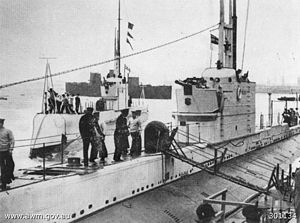Odin class submarine

Oxley and Otway
|
|
| Class overview | |
|---|---|
| Name: | Odin class or O class |
| Operators: |
|
| Preceded by: | L class |
| Succeeded by: | Parthian class |
| In commission: | 22 July 1927—1959 |
| Completed: | 12 |
| Lost: | 6 |
| Retired: | 12 |
| General characteristics | |
| Type: | Submarine |
| Displacement: |
|
| Length: |
|
| Beam: |
|
| Propulsion: |
|
| Speed: |
|
| Range: | |
| Test depth: | 300 ft (91 m) |
| Complement: | 54 |
| Armament: |
|
The Odin-class submarine (or "O class") was a class of nine submarines developed and built for the Royal Navy (RN) in the 1920s. The prototype, Oberon, was followed by two boats originally ordered for the Royal Australian Navy, but transferred to the RN in 1931 because of the poor economic situation in Australia, and six modified boats ordered for the RN. Three modified boats were built for the Chilean Navy as the Capitan O'Brien-class submarines in 1929.
The class was built to replace the ageing L-class submarines which did not have adequate endurance for use in the Pacific Ocean. These boats were theoretically able to dive to 500 feet (150 m), though none were formally tested beyond 300 feet (91 m). Armament consisted of eight 21-inch (533 mm) torpedo tubes (6 bow, 2 stern) and one 4-inch (102 mm) gun. The boats were of a saddle tank type with fuel carried in riveted external tanks. These external tanks proved vulnerable to leaking after depth charge damage betraying the position of the submarine. These boats were the first British submarines fitted with Asdic and VLF radio which could be used at periscope depth.
Oxley-class submarines :
Odin-class submarines:
...
Wikipedia
